**Same reminder as the beginning of the last post: if you’re receiving this by email, the post and pictures look significantly better on the website, so please click on the title and it will direct you there!
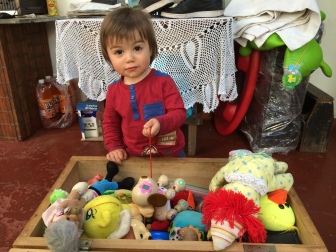
Host baby Leonardo
I cannot believe we have been in Chile almost a week already – it feels like we’ve been here for much longer than that. Things have improved significantly since I last posted, mostly because our school has started, which means I’ve been in other parts of Santiago besides Ñuñoa! I do like living in Ñuñoa, but it’s very suburban, and I like to be around lots of movement, things to do, and places to explore.
The climate in Santiago is very temperate – it is spring right now (I LOVE smelling the blooming flowers), but the temperature fluctuates constantly, so I bring layers everywhere. I’ve had many instances where I go back and forth between feeling warm and cold, but luckily I packed in layers (capas). During the day, I am usually in a t-shirt and shorts, which is funny compared to everyone else on the metro (the subway) or in the streets, as they wear coats and pants. By nighttime, the temperature drops significantly, and I go to bed in sweatpants and a fleece shirt, sometimes adding my fleece jacket onto that.
CHILEAN MEALS – the food culture here is totally different than in the U.S. in many ways. The two foods at every meal are white bread and mashed avocado (palta). Chileans eat a lot of the same foods that the U.S. does, but meals are set up totally differently.
- Breakfast (desayuno) is usually eaten between 10 and 11am, and it’s
pretty light. There are toasted bread rolls (always white), jam, butter (vegan for us!), peanut butter, mashed avocado, tea and coffee, and leftover cake if there is any. We told our host mom Aly that we eat oatmeal (avena) for breakfast, so she prepares that for us every day. I know living abroad requires flexibility, especially with food, but since oatmeal is easy to buy here and is much healthier, I’m very happy that we have it. - Lunch (almuerzo) is usually around 2pm, and is the main meal of the day. It often has multiple courses – here was one of ours:
- Tea or coffee
- Artichoke (alcachofa) and a lettuce salad
- Soup of poroto, which is another word for beans (instead of frijoles) – I LOVE this dish.
- A stir fry of rice noodles with corn (the Chilenismo is choclo, instead of maíz), carrots (zanahorias), and peas
- Strawberries in the juice from jarred peaches
- Dinner – Chileans don’t eat a “normal-sized” dinner – instead, it is called once (pronounced “ohn-say”, like the Spanish pronunciation of the number eleven;
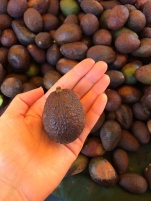
Baby avocado! A real paltita
because I’m in Chile, where people drop the s’s on almost all of their words, it is usually pronounced without the s). Once is essentially an evening snack, with tea and coffee (of course), bread, butter, jam, peanut butter, and mashed avocado. There is sometimes some sort of deli meat on the table with breakfast and dinner for the rest of the family. Occasionally, Aly makes Jordin and me a vegetable dish, while the rest of them “tomar once” (to take once): last night was grilled vegetables with tomato sauce of many other veggies, spices, and carne vegetal (vegan meat substitute) – it was delicious.
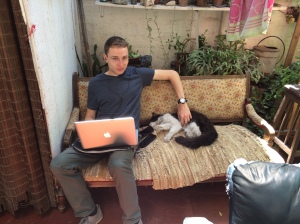 In my first post, I mentioned that Chileans add “ito” or “ita” to words even when the object isn’t small, which the ending usually means. Well, I only realized a few days ago that our host cat, Pancito, is named after pan (bread)…pan + ito = Pancito. How I interpret this is that our host family needed even more bread in their lives because there wasn’t enough already, so the cat needed to be named after bread to fulfill it.
In my first post, I mentioned that Chileans add “ito” or “ita” to words even when the object isn’t small, which the ending usually means. Well, I only realized a few days ago that our host cat, Pancito, is named after pan (bread)…pan + ito = Pancito. How I interpret this is that our host family needed even more bread in their lives because there wasn’t enough already, so the cat needed to be named after bread to fulfill it.
On Friday night, Jordin and I went out with one of his friends from Tufts who is studying abroad in Santiago this semester, and three of his Chilean friends. We ended up going to a bar called “St. Patrick’s Day Bar” – definitely immersing ourselves in typical Chilean bar culture! Even though we only spoke in Spanish and the bar actually was filled with Chileans, it reminded me of a bar I went to in Vietnam called “Local Bar” (in English), and it was only foreigners. Here in Chile, I ordered my first pisco sour, which is a popular Chilean drink. It is made from pisco, which is a brandy-like drink made from grapes. I only found out afterwards that the drink usually contains egg white (oops), but I also read that Chilean pisco sours often don’t use egg whites, so I’ll have to ask next time.
On Saturday night, Jordin and I had absolutely no plans (#nofriends #yet), so we had a fun night in with Aly and Sergio. They made us “terremotos”, a popular Chilean drink (the word also means earthquake): pineapple ice cream (pineapple sorbet for us, though Aly told us it’s usually made with this), Pipeño (a special type of wine), and grenadine. Over drinks, we talked about all sorts of things, and I felt like it was a bonding moment with them. Afterward, Sergio put on popular Chilean music, and we talked about dancing and music in various countries, among other things.
On Sunday after breakfast, Aly and Sergio took Jordin and me to a farmers market (called a feria) in the nearby neighborhood of Peñalolén (it’s far enough from Ñuñoa to drive there, but is only about 15 minutes away). This market was a long line of produce stands, as well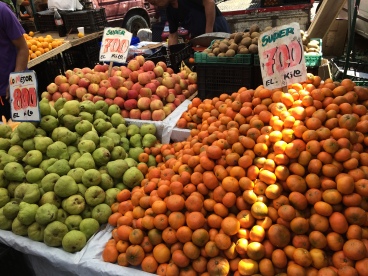 as stands selling household items and clothes. Aly and Sergio bought lots of fruit and vegetables, and we got to taste many samples along the way. At one stand, the man working it made Jordin take a bag of lettuce and his reasoning was because Jordin is a gringo (a word often used to describe foreigners, especially a white person from the United States). We didn’t actually get it for free, but it was funny because then the man started talking with Sergio about Jordin being a gringo as if we couldn’t understand (I’ll be honest – I didn’t get most of it because it was so fast). It’s interesting for me to compare my experiences in Santiago and Buenos Aires, because when I was in Buenos Aires, I didn’t stand out at all. The result of decades of European immigration to Argentina is that much of the population in the city is white – it was only when I went outside of the city that people looked more stereotypically Hispanic. Here in Santiago, most of the population looks more Hispanic, so it’s much easier for Jordin and me to stand out.
as stands selling household items and clothes. Aly and Sergio bought lots of fruit and vegetables, and we got to taste many samples along the way. At one stand, the man working it made Jordin take a bag of lettuce and his reasoning was because Jordin is a gringo (a word often used to describe foreigners, especially a white person from the United States). We didn’t actually get it for free, but it was funny because then the man started talking with Sergio about Jordin being a gringo as if we couldn’t understand (I’ll be honest – I didn’t get most of it because it was so fast). It’s interesting for me to compare my experiences in Santiago and Buenos Aires, because when I was in Buenos Aires, I didn’t stand out at all. The result of decades of European immigration to Argentina is that much of the population in the city is white – it was only when I went outside of the city that people looked more stereotypically Hispanic. Here in Santiago, most of the population looks more Hispanic, so it’s much easier for Jordin and me to stand out.
On Monday, Jordin and I are started our English-teaching certification class to get our TEFL/TESOL certificates! We had our first day of school together for the first time in 5 years, since the beginning of senior year of high school. I am so excited to start having a routine and somewhere to go every day, because even though I like Ñuñoa, I was getting a little tired of being in the house with very little activity for four days. Our school is in Providencia, which is a business/financial section of Santiago. Our commute is 25-30 minutes, which isn’t much in Santiago: we walk 8 minutes to the metro, have an 8 minute metro ride (only 4 stops), and walk another 8 or so minutes to our school. Very easy! Our class starts at 10am, which is great for sleep benefits, but also because the busiest commuting hours are from 7-9am, and we leave around 9:15am (though the metro is still pretty crowded). Our class typically will end between 5 and 5:30pm, and rush hour in the evening is 6-8pm, so it will be pretty crowded for us at night. The class is six people, all from the U.S., and everyone comes from totally different backgrounds, schooling, and experiences – I like them all. The only problem is we speak in English all day, so we’re used to speaking that and often continue it when we leave school – we sometimes speak Spanish, but it’s so easy to revert to English that by the end of the day, I find myself longing to speak Spanish. I want to continue hanging out with my classmates, but I need to be really careful about speaking so much English – we all speak a fair amount of Spanish, so I’m going to try to enforce that more. More updates on school next time!
We got out of class early on Monday and Tuesday, which means we had time to explore, which I have been wanting to do since the day I got here. On Monday, we walked to the Costanera Center, which is a skyscraper a few blocks from our school, and it is also the tallest building in Latin America! It has a six-floor shopping mall (to be honest, I didn’t know there were many malls bigger than King of Prussia), offices, and lots of food. On Tuesday, we went to Cerro San Cristóbal, which is in an area called Bellavista – cerro means hill, and Santiago is full of them. The peak of this hill is the second highest point in the city, so it has fantastic views – we went yesterday because it rained on Monday night, which means the smog clears up somewhat. You can take a tram or walk up, and at the top, there is an enormous statue of Virgin Mary (I assumed it was San Cristóbal, but learned it wasn’t after some research), a small room for prayer below the statue, and a chapel for services. The views were incredible – it’s hard to realize how big Santiago is (and how big and beautiful the mountains are) before seeing this.
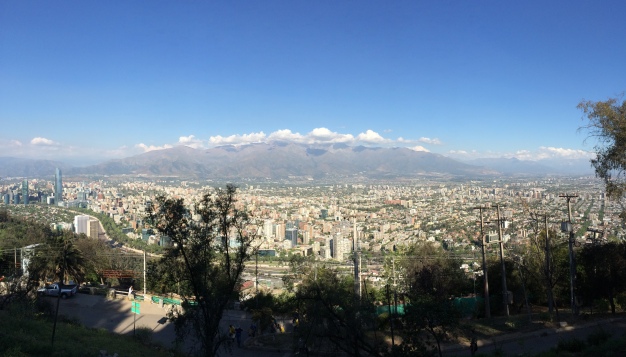
You can see the Costanera Center (tallest building in Latin America) on the left!
A little more information on Chilenismos before I list some new ones I’ve learned – much of this localized slang has been adapted from language of the Mapuche, a group of indigenous people from parts of Chile and Argentina. Not only do Chileans speak incredibly fast, but they often slur their words, drop final syllables (“algo más?” becomes “alg ma?”; helado, ice cream, which should be pronounced e-la-do, becomes e-lao), and ignore the final s’s. I am slowly learning the most common Chilenismos, but I have many more to go.
- Po –this is a suffix that has absolutely no significance; it’s used the way we say “so” or “well”, so it’s often placed at the end of phrases: “sí po”. There’s a popular party every Wednesday in Santiago specifically for extranjeros (foreigners) called “Miercolespo” (Wednesday + po). No real reason for the po, but that’s how Chileans do.
- Pololo/a is used in place of novio/a, which means boyfriend/girlfriend. Apparently, using novio/a here means that you’re getting married – so they only use pololo/a.
- Taco – no, not the Mexican food, but used to describe the morning/evening commute in the traffic: there is “mucho taco”. When we tried to take the metro somewhere tonight at 7pm, the ENTIRE station was filled with people in line to get down to the metro – think of an entire train station filled with people. You can’t move anywhere.
- ¿Cachai? means “do you understand?”. Apparently Chileans often ask people they believe are extranjeras this to see if they really understand it, but I’ve yet to be asked. Another interesting tidbit: Felipe, the boyfriend of our host sister Javiera, told us that in Peru, this word means “to fuck”, so asking someone “Cachai?” means “You make love?” Good to know.
- Additionally, when we were at the farmers market over the weekend, I happened to notice a handful of people wearing shirts with English phrases on them, the best of which I will give you the pleasure of reading now (as I did when finishing my blog posts in Argentina):
- “You Make My Day”
- “Limited Edition”
- And the best: “B-ball is my favorite sport because golf, tennis, and baseball have small balls”
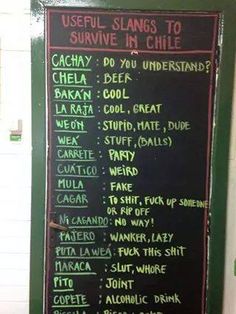
Not my photo, but helpful (to me)!
I have to go write a lesson plan for my first class on Friday – I’m teaching prepositions of time. Even though we’ve only been in class 3 days, I feel like I’m getting the hang of things, so I’m not terribly worried about the teaching, but it requires mucha preparación! We just got back from salsa dancing, so I’m pretty tired – while I could’ve used that time to work on the lesson plan and read more chapters in the textbook, I’m going to take full advantage of living in this amazing country and exploring all it has to offer. Besides, I read the chapters for tomorrow earlier, and I have tomorrow night for the lesson plan – good to know that I’m keeping up my procrastination even though I’ve been out of college for 4 months!
Until next time! Besitos y abrazos!
Very exciting Rach! We’re proud of you and Jordin!
LikeLike
Your adventure sounds wonderful so far. So glad you have Jordin for companionship. Living with a baby must be a world away from college life.
Love reading your posts.
LikeLike